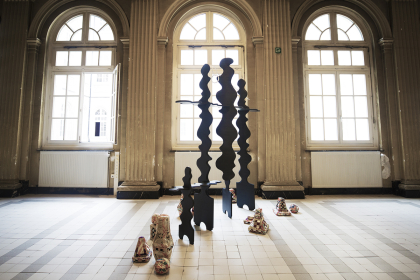Mathias Prenen (°1990, Geel)
Lives & works in Brussels (BE)
Mathias Prenen (b. 1990) obtained his master’s degree in fine art and sculpture from KASK in Ghent and studied lacquering and textiles at Kanazawa College of Arts in Japan. His mostly sculptural works range from large-scale installations to small objects. Prenen is interested in different ways of sculpting and is skilled in traditional techniques, such as chiselling and modelling, as well as more modern approaches, for example chainsaw carving. His multimedia practice gives rise to imaginative and visually arresting works with a pronounced focus on materiality and anthropological significance.
Mathias Prenen’s sculptures are situated between abstraction and representation. Cushions shaped like architectural ornaments and table legs that behave like sex toys are just two examples of how he questions our understanding of form. The totem-like objects in the #BALUSTER# series, such as #BALUSTER#SeiShonagon and #BALUSTER#CarmenMiranda, serve as allegorical markers within the artist’s aesthetic universe. To create these works, Prenen combined the shape of a 15th-century baluster ornament from the Western architectural tradition, which here serves as an archetype, with images of writers and entertainers from different continents and historical periods. The titles are derived from the ensuing cultural mash-ups – Carmen Miranda being a famous Brazilian samba dancer from the 1950s and Sei Shōnagon being a pre-eminent female writer of the 11th-century Heian period in Japan. Through these works, Prenen considers the way in which the cultural essence of the artists is diminished by mass media, the burden of modernism and the society of the spectacle.
The more architectural installations, such as the modular #KOCHU series, reference the temporary structures that are used to present, display or house culture, for example art fair booths, gallery walls and pedestals. The Japanese word kochu, which dates back to the Edo period, describes the way in which the mind is directed towards the universe during a traditional tea ceremony. The series of modules can house anything and therefore function as carriers of emptiness. Prenen strives to heighten people’s experiences by creating spaces that encourage mental openness.
Prenen is fascinated by materials and their historic and socio-cultural significance. The #YU series in Urushi lacquer paint was the result of an extensive period of research into the material properties, traditional applications and cultural value of the medium. By combining the Urushi resin with a number of less orthodox materials, the artist is able to show it in a new light. Prenen situates the unexpected qualities of the medium within a broader cultural history and, in so doing, creates an intercultural story suspended in time.
Mathias Prenen links avant-garde artistic concepts and Surrealism with the notion of dislocation in his works. He shows how every form is a kind of artificiality but, equally, that this condition can be overcome












